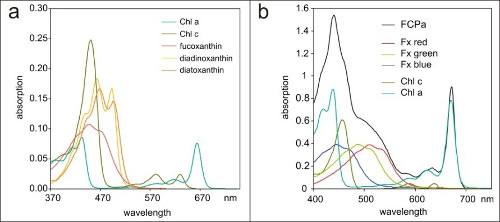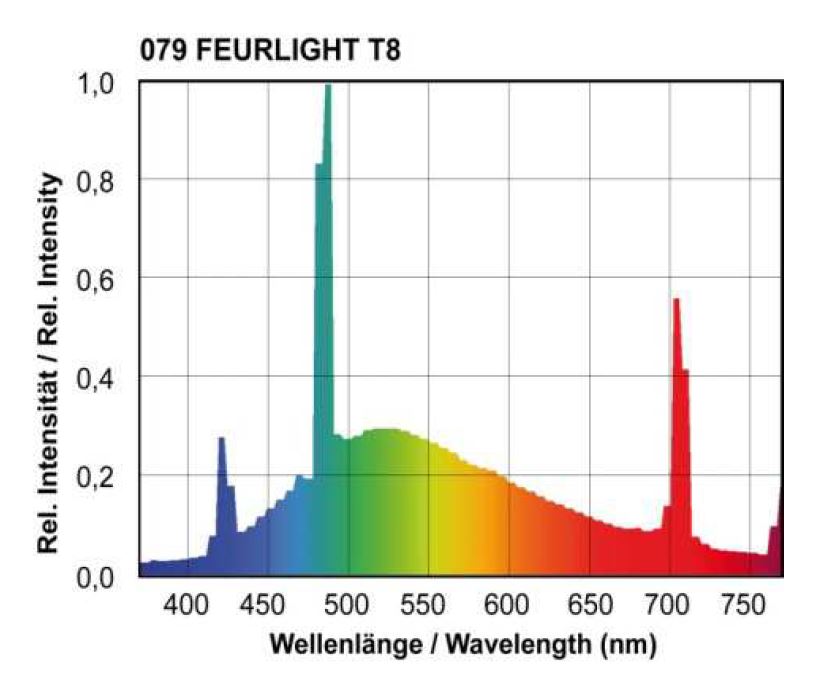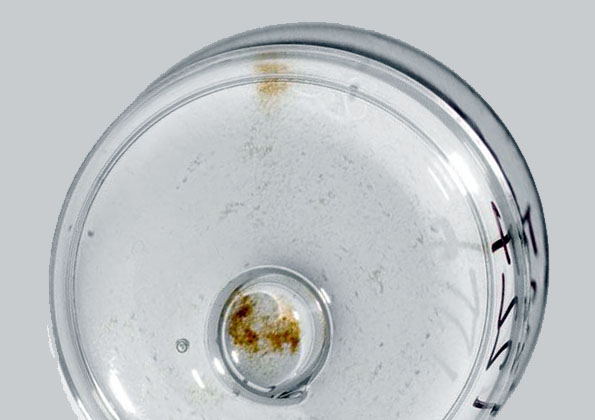
Light and Lighting
Like all algae, diatoms photosynthesize. They assimilate inorganic carbon dioxide for conversion into organic substances. For this reason, it is necessary to cultivate diatoms in the light.
Collected samples can be kept for a few days at a shady window. Light stress due to direct sunlight should be avoided. Diatom cultures however are better cultivated with an artificial light source. You are able to control the conditions, brightness and lighting can be varied and one is not dependent on the weather or the season. This is advantageous, even if no larger biomass is to be obtained. For the selection of the illuminants, a few remarks are made here.
Spectrum
The following illustration shows the absorption spectra of the pigments (1 mM in acetone, a) and a light-harvesting complex (FCPa from Cyclotella meneghiniana, b):
 |
| Figure from “Untersuchungen zur Struktur und Funktion von photosynthetischen Proteinen in Eukaryoten" (www.bio.uni-frankfurt.de/43967656/forschung) by courtesy of Prof. Dr. Claudia Büchel, Institute for Molecular Bioscience, Goethe University, Frankfurt am Main, Germany |
As with green algae and land plants, the absorption spectrum shows maxima in the blue and red portions of the spectrum. Carotenoids such as the mentioned fucoxanthin also make it possible to use the light even in the green. This ability gives them an advantage over green algae. It is therefore quite useful to offer diatoms green light.
|
|
 |
In nature, diatoms receive the sunlight filtered through the water. Several meters below the water surface, the red portion is already quite small. Planktic living species do not possess motility and have to cope with unfiltered sunlight as well as blue light in different brightness. You can conclude from this that the requirements for lighting the cultures cannot be very critical. We also do not focus on optimizing the yield.
It is very unfavorable to keep diatoms in exclusively or predominantly red light. In red light they are not able to measure the light intensity. Their reproduction is severely limited (Schellenberger, Costa et al. 2013). Apparently the blue sensitive aureochrome has to be stimulated, which interacts with the red sensitive phytochrome, so an irradiance measurement and adjustment of the metabolism can take place.
Our attempts of cultivation in the light of white LED lamps with low color temperature were not successful, which should be due to the barely usable blue spectral component. There are, however, LED lightings for aquariums that should be well suited.
It would be possible to use a conventional bulb with a blue filter for cultivation. If one uses a filter of in water dissolved copper sulfate, the spectrum of sunlight in a few meters of water depth can be reproduced well (Davis, Harrison, Dugdale (1973)). In view of the immense waste of primary energy, this does not seem to be a practicable and up-to-date method for cultivation.
The picture at the top shows in the middle a LED grow lamp (Lunartec FAST GROW PRO Ø 125 mm - blue: 460 - 465 nm, red: 625 - 630 nm), which has blue and red LEDs (See picture on the left) and is mainly offered for land plants, but has proven itself well for diatoms. Apparently the manufacturer specifies a range around the maxima of the red and blue LEDs. Below the lamp the spectrum is shown, which was recorded by us with a spectroscope. The width of the red and blue bands is so large that the red LED can also contribute to photosynthesis of the diatoms.
Well suited are conventional fluorescent lamps with a high color temperature of approximately 6000 Kelvin as offered for use in an office. This is the low-cost way of illumination.
On the left side of the picture at the top you see cultures illuminated by the fluorescent lamp for plants LT - T8 18 W FLEURLIGHT by NARVA. The corresponding emission spectrum can be seen on the left (by courtesy of NARVA Lichtquellen GmbH + Co. KG).
I am also very satisfied with the fluorescent lamp Biolux 965 from Osram. Meanwhile general lighting products of OSRAM are outsourced to LEDVANCE GmbH. Unfortunately LEDVANCE did not agree to reproduce the emission spectrum here. You can find it at this link. This fluorescent lamp simulates the daylight and is often used in keeping reptiles, but also birds and fish. The color temperature is very high with 6500 Kelvin. As the spectrum shows, a considerable proportion of UV-A (380 nm to 315 nm) is also present. Petri dishes made of polystyrene absorb a high degree of UV light, so that there is hardly UV-Irradiation to be present in the cultures. I could not observe a harmful influence compared to the other lamps.
Light intensity
As mentioned already, diatoms must be able to adapt to changing light conditions. As the lifetime of the culture and not the yield of biomass is the focus of our applications, we keep the light intensity relatively low.
In general, the dimensioning of lighting depends strongly on the type of cultures. For larger culture vessels and high cell densities, a higher brightness of the illumination is required in order to penetrate sufficiently through the culture. From the cultivation in petri dishes over erlenmeyer flasks to large vessels the required intensities increase (see www.fao.org/docrep/003/w3732e/w3732e06.htm#b12-2.3.1.2.%20Light).
In addition, the mixing of culture is becoming increasingly important. Incidentally, for large cultures aeration is required.

At low light intensities the growth rate vs. intensity increases linearly (observed at Ditylum brightwellii). At higher intensities the function flattens (Paasche (1968)). We cultivate diatoms between 200 lux and 600 lux. This is well above the light compensation point and probably in the linear regime. The brightness depends on the location where the petri dish is placed and can be selected as required.
It has been shown that the light requirements for the different species are not the same. As is well known some motile species show phototaxis. They control the duration of the movement in the same direction in a way that they reach favorable conditions. At low light intensities a positive phototaxis is expected and at high intensities a negative. This can be used to find a favorable light intensity (hint by Dr. Oliver Skibbe). If a fluorescent lamp is placed vertically (in the upper right corner of the image at the top), the diatoms can move towards or away from the light source. In addition, there is a brightness gradient within the petri dish. The picture shows a culture of Nitzschia sigmoidea, in which a ring of thin steel plate was inserted. It touches the ground only at a few points so that diatoms can easily migrate between the outer and inner region. In the selected lighting direction, the bottom of the tray is shaded within the ring. As can be seen, the diatoms preferentially accumulate within the ring. A small portion of Diatoms can be seen on the upper edge of the Petrischale, which is turned away from the light source. A light intensity of only 200 lux seems unpleasantly bright for this species. Unfortunately only a few species show a clearly recognizable phototaxis under our light conditions. In our collection this concerns particularly species of genera Nitzschia and Cymbella.
When the population reaches its highest density, a high light intensity quickly leads to the enrichment of the diatoms with reserve materials.
Light-dark Cycle
At least at high light intensities, there is a reduction in the growth rate in the case of permanent illumination (Paasche (1968)). Some species seem to prefer a light-dark cycle. This is in particular true for freshly isolated cells (Andersen, Kawachi (2005)).
We use a daytime cycle with about 12 hours light per day. For mass cultivation at least 18 hours of light are recommended (http://www.fao.org/docrep/003/w3732e/w3732e06.htm#b12-2.3.1.2.%20Light).
In terms of light intensity, diatoms are quite robust. They stand a postal dispatch of a few days easily.
Schellenberger, Costa et al., Aureochrome 1a is involved in the photoacclimation of the diatom Phaeodactylum tricornutum. Plos One 8: e74451, 2013.
Davis C.O., Harrison P.J. & Dugdale R.C. (1973) Continuous culture of marine diatoms under silicate limitation I. Synchronized life cycle of Skeletonema costatum. J. Phycol. 9, 175-80.
Paasche E. (1968) Marine plankton algae grown with light-dark cycles. II Ditylum brightwellii and Nitzschia turgidula. Physiologia Pl. 21, 66-77.
Andersen R.A., Kawachi M. (2005) Traditional Microalgae Isolation Techniques. Algal Culturing Techniques, Robert A. Andersen (Editor) Academic Press






